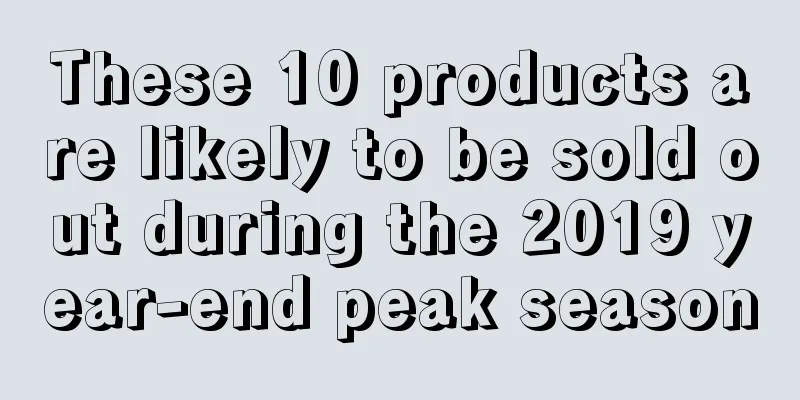A single link can generate 10-50 orders per day, with white hat promotion and operation strategies at different stages!

|
A product has a life cycle, which is usually divided into the new product period, the growth period, and the stable period. New product period: This is when the product is just launched on the shelves. At this time, there are no reviews and no rankings for keyword searches. Advertising is needed to create exposure opportunities for the product. After all, only with exposure can conversions be achieved. At this stage, you don’t have to worry too much about the ACOS of the ad. Instead, you should focus on whether the product is exposed enough and find a better source of traffic. Therefore, the budget must ensure that the ad is not interrupted, and the bid should not be too much lower than the recommended value. Rising stage: The product has been sold every day, has some reviews, and has been ranked in small categories, but you want to further explore the potential of the product. At this time, you need to pay attention to the conversion rate and trend of the product. Amazon's algorithm has a greater traffic bias towards products with good sales and conversion. At this stage, the advertisement must control the conversion rate, timely deny or archive keywords with poor performance, and at the same time, the budget must be sufficient, otherwise once the advertisement is interrupted, the previous weight will drop. Mature stage: The sales volume and ranking of the product are stable, and it can continuously bring profits to the sellers. The key point here is the profit margin of the product. If it is not profitable in the mature stage, the cost of the previous promotion stage will be wasted. In this stage, the advertising budget must be controlled well, and the profits cannot be burned all at once. At the same time, it must be adjusted according to market changes to maintain stable exposure. What goals are suitable for different periods?Start-up phase: focus on expanding traffic, providing sufficient budget, increasing advertising bids, etc., to gain more exposure and push products to the homepage. Growth stage: focus on improving conversions, continuously ensure advertising budgets, establish product labels through SP and SB advertising, and stabilize product rankings. Mature stage: focus on increasing profits and conversions, controlling product pricing, controlling advertising costs, ensuring product sales, and stabilizing product rankings. Recession stage: focus on controlling costs, reducing advertising bids and product pricing, and clearing out excess inventory. When we make a new product, our ultimate goal is to become the bestseller, so let’s take a look at the specific operations of the product at different stages. 1. How to break 0 orders for new products? -----Exposure and traffic are the basis The first order of a new product is like a piece of gold. Amazon will provide traffic support for the new product listing, which means that this product itself has traffic. In the new product stage, products have no reviews, no rankings, no loyal customers, and are not competitive. At this time, in order to allow the products to enter the market quickly, sellers may wish to set the price lower. 2. How to accumulate orders for new products? ----- Conversion is king When your store can continue to receive orders every day, we will focus on operating it. At this time, if your store wants to increase sales, conversion rate is the key. When you have the first order, the platform will continue to give you more traffic. The traffic that Amazon gives you can be effectively improved by optimizing the main picture, title, five-line description, and background keywords of Liting, which is an effective way to quickly increase the conversion rate. This work must be done in detail. The main picture must be compared with competitors, and the title must be compared with competing local sellers. The five-line description needs to be different. 3. How to break through from 10-50 orders? ----- Ranking is the key At this time, your listing should have at least 30 reviews and ten orders per day, which means your listing conversion rate is in line with Amazon’s algorithm. A conversion rate of at least 10% is considered qualified. 4. Set goals, optimize listing quality, find product differentiation, and increase product profits. When the listing ranks 20th in a subcategory, what we need to do on a daily basis is to monitor the various indicators of the top 19 competitors. When the product was first put on the shelves, we mostly imitated the advantages of competing products. What we need at this stage is differentiation, so that buyers can feel that our products are unique. Our purpose in doing business on Amazon is to make money, not to give products to foreigners for free. Therefore, profit is something that must be considered after ranking up. 5. Stabilize the Review rating and review steps 1-4 to see if there are any errors. At this stage, our products have begun to make profits, but no matter how good your product quality is, there will be negative reviews. After all, our thinking is different from that of foreigners, and it is difficult to take into account the needs of everyone. At this time, you need to be prepared to contact the negative review customers at any time and handle the negative reviews well. At this stage, the main task is to deal with negative reviews and increase 5-star reviews. If you can really achieve 4.5 stars or above, the platform will give you more traffic. At the same time, choosing a better logistics channel to reduce costs is also a simple and crude way to increase profit margins at this stage. During the entire product promotion period, you need to focus on the listing ranking and core keyword natural search ranking every day, and keep the core keyword natural search ranking on the homepage. Pay attention to competitors' dynamics. Control the ACOS of ads, increase ad bids and budgets during flash sales and off-site promotions, and turn off ads with ACOS values greater than or equal to gross profit margins, and only keep profitable ads. If the ACOS of core keywords is higher than the gross profit margin, check the quality of the listing. 1. Exposure If a product’s exposure data is not high during promotion, it may be caused by the following two factors: 1) The listing content and core keywords are not accurate, and the system cannot identify them properly 2) The product bid is too low and the system does not give enough exposure. In the first case, if you want to increase product exposure, you should first check the details of the product listing, whether the category selection is accurate, whether the core keyword description is appropriate, whether the core keyword coverage is comprehensive, etc. If these factors are improved, the product exposure will begin to increase under normal circumstances. Sellers who need to arrange off-site promotion and unboxing videos, please contact customer service V: FLA66668888 If all elements of the listing are complete but the exposure rate is still very low, it may be the second situation. In this case, the seller only needs to increase the advertising bid of the product appropriately to obtain higher exposure. 2. Clicks If there is no problem with exposure, the second data that sellers need to pay attention to is the click-through rate, that is, the number of consumers who click in after seeing your product promotion. Under normal circumstances, the ratio between clicks and impressions, that is, CTR, should be around 0.5%. If it is lower than 0.5%, we need to find out the reasons for the low CTR, which are usually the following two points:
The methods to increase product clicks and exposure are actually similar. First, optimize the main image of the product listing, enhance the quality of the image, improve the presentation effect, and attract consumers to click. Second, adjust the product advertising bidding to change the advertisement to a position that can generate more exposure. 3. Order conversion rate In the early stage of advertising promotion, sellers should pay more attention to the order conversion rate, that is, the conversion rate from consumer clicks to orders, rather than ACOS. According to normal operational big data, an order conversion rate of around 15% is normal. If it is lower than this value, there may be several reasons: 1) Listing optimization is not in place, making it difficult to encourage consumers to place orders 2) The product price is too high, exceeding the consumer's psychological expectations. There are too few reviews, or too many negative reviews. Sellers can try to improve order conversion rate through the following suggestions: 01 Continue to strengthen Listing optimization. You can analyze several competitors’ core words, find out the core word roots and combine them to create core words that suit you. 02 Adjust product prices. When the impact on store operating profits is not significant, appropriately lower product prices to guide consumers to place orders. 03 Make corresponding optimizations based on the opinions raised by negative reviews to reduce the negative impact caused by them in the future 4. ACOS ACOS is the percentage obtained by dividing the advertising expenditure in a certain period of time by the sales amount brought by advertising during that period of time. Advertising bidding, product price, click volume, and order volume will all cause changes in ACOS. Among the variables that affect ACOS, click volume and order volume are the results generated later, but the advertising bid and product price can be adjusted by the seller. By analyzing the relevant data and making targeted interventions, the ACOS value can be effectively reduced. The specific methods are as follows: 01 Lower your bid Lowering the bid can reduce ACOS to a certain extent, but this will also reduce ad exposure accordingly, so it cannot be the first choice. 02 Improve conversion rate Optimizing the existing product listing and eliminating invalid traffic can increase the conversion rate of the advertisement accordingly without any negative impact. When the ACOS is too high, you can first try to increase the conversion rate. 03 Adjust product prices Under normal circumstances, the selling price of a product tends to increase inversely with the conversion rate. Therefore, the selling price of the product can be adjusted according to actual conditions. The ultimate goal is to increase the product of the conversion rate and the sales price. |
<<: Amazon officially defines the latest standards for manipulating and abusing review violations!
>>: Amazon updates the latest "shopping cart" gameplay, and sellers are shocked!
Recommend
Cross-border version of 3.15: Account selling service providers and Amazon’s 350,000 product sales have all collapsed!
The annual 315 Party came as scheduled. At the mee...
Solution steps - the product was mistakenly identified as a pesticide product and therefore cannot be sold
If a product is mistakenly captured as a pesticid...
Sellers' orders dropped sharply! A large-scale Internet outage suddenly occurred in the United States!
Today, many foreign media reported that the East ...
What is LGS? LGS Review
LGS is the only logistics service provider for all...
Free returns extended! Amazon officially announced…
According to Techspot, Amazon plans to expand its ...
China's monthly export volume hits a record high! Behind it is a $5 global express delivery network
This is a great reversal. In November 2020, China...
Teach you how to optimize your listing to improve PPC performance
How to optimize your Amazon listings to better at...
What is the Hague Agreement Concerning the International Deposit of Industrial Designs? Review of the Hague Agreement Concerning the International Deposit of Industrial Designs
The Hague Agreement concerning the International D...
What is Diandong? Diandong Review
Xiamen Diantong Mdt Infotech Ltd. was established ...
Beware! These Google Ads Misconceptions May Affect Your Cross-Border E-Commerce Business
As a cross-border e-commerce company, have you eve...
What is British Tempus Accounting Firm? British Tempus Accounting Firm Review
The British accounting firm Tempus was founded in ...
Several ways to obtain Amazon's off-site resources
How to obtain external resources: 1. Analyze the d...
Amazon is about to restrict this feature...
In the coming February, in addition to the people...
Following the United States Postal Service, FedEx also announced its peak season surcharge!
It is learned that following the United States Pos...
Can storage capacity be auctioned? Amazon's storage capacity policy may be overhauled
According to the latest foreign media reports, Ama...









